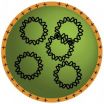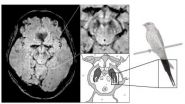(Press-News.org) Working together, Johns Hopkins biomedical engineers and neurosurgeons report that they have created tiny, biodegradable "nanoparticles" able to carry DNA to brain cancer cells in mice.
The team says the results of their proof of principle experiment suggest that such particles loaded with "death genes" might one day be given to brain cancer patients during neurosurgery to selectively kill off any remaining tumor cells without damaging normal brain tissue.
A summary of the research results appeared online on April 26 in the journal ACS Nano.
"In our experiments, our nanoparticles successfully delivered a test gene to brain cancer cells in mice, where it was then turned on," says Jordan Green, Ph.D., an assistant professor of biomedical engineering and neurosurgery at the Johns Hopkins University School of Medicine. "We now have evidence that these tiny Trojan horses will also be able to carry genes that selectively induce death in cancer cells, while leaving healthy cells healthy."
Green and his colleagues focused on glioblastomas, the most lethal and aggressive form of brain cancer. With standard treatments of surgery, chemotherapy and radiation, the median survival time is only 14.6 months, and improvement will only come with the ability to kill tumor cells resistant to standard treatments, according to Alfredo Quiñones-Hinojosa, M.D., a professor of neurosurgery at the Johns Hopkins University School of Medicine and a member of the research team.
Because nature protects the brain by making it difficult to reach its cells through the blood, efforts turned to the use of particles that could carry tumor-destroying DNA instructions directly to cancer cells during surgery.
The initial experiments made use of cancer cells that Quiñones-Hinojosa and his team removed from willing patients and grew in the laboratory until they formed little spheres of cells, termed oncospheres, likely to be the most resistant to chemotherapy and radiation, and capable of creating new tumors.
Quiñones-Hinojosa then worked with Green to find a vehicle for genes that would cause death in the oncospheres. Green's laboratory specializes in producing tiny, round particles made up of biodegradable plastic whose properties can be optimized for completing various medical missions. By varying the atoms within the plastic, the team can make particles that have different sizes, stabilities and affinities for water or oil. For this study, Green's team created dozens of different types of particles and tested their ability to carry and deliver a test sequence of DNA — specifically a gene for a red or green glowing protein — to the oncospheres.
By assessing the survival of the cells that engulf the particles and measuring the levels of red or green light that they emitted, the researchers determined which formulation of particles performed best, then tested that formulation in mice with human brain cancer derived from their patients.
They injected the particles directly into mice with an experimental human brain cancer, and into the brains of healthy mice for use as comparison. Surprisingly, healthy cells rarely produced the glowing proteins, even though the DNA-carrying particles were entering tumor cells and non-tumor cells in similar numbers. "This is exactly what one would want to see, cancer specificity, but we are still researching the mechanism that allows this to occur," says Green. "We hope our continued experiments will shed light on this so that we can apply what we learn to other scenarios."
"It is exciting to have found a way to selectively target gene delivery to cancer cells," says Quiñones-Hinojosa. "It's a method that is much more feasible and safer for patients than traditional gene therapy, which uses modified viruses to carry out the treatment."
He adds that the particles can be freeze-dried and stored for at least two years without losing their effectiveness. "Nanoparticles that remain stable for such a long time allow us to make up formulations well in advance and in large batches," says Stephany Tzeng, Ph.D., a member of Green's team. "This makes them easy to use consistently in experiments and surgeries; we add water to the particles, and they're good to go."
In a related study, published online on March 27 in the same journal, Green's group also showed that a different particle formulation could effectively carry and deliver so-called siRNAs to brain cancer cells. siRNAs are very small molecules that carry genetic information to cells, but unlike DNA that can turn genes on, siRNA interferes with the production of particular proteins and can turn cancer genes off.
Green explains that siRNAs must be encapsulated in particles that are different from those used to carry DNA because siRNAs are about 250 times smaller than the DNA molecules usually used for gene therapy. "siRNAs are also much stiffer than DNA, and they don't have to enter the cell nucleus because they do their work outside it, in the cytoplasm," he says.
An initial library of 15 biodegradable particle formulations was tested for their ability to carry siRNAs into human glioblastoma cells that were genetically engineered to make green fluorescent protein (GFP). The siRNAs added to the particles contained the GFP code, so successfully targeted cells would stop glowing green.
By tweaking the chemical properties of the particles, the team was able to find a composition that decreased GFP's glow in the human brain cancer cells by 91 percent. To test the ability of the particles to deliver death-inducing siRNAs, the team loaded the particles with a mixture of siRNA codes designed to prevent important proteins from being made. They then added these particles to brain cancer cells and to non-cancerous brain cells growing in the laboratory.
As in their mouse study, the siRNA was more effective — in this case at causing cell death — in the brain cancer cells (up to 97 percent effective) than in the non-cancerous cells (0 to 27 percent, depending on nanoparticle type).
Green emphasizes that for nanoparticle-based genetic therapies that are safe for patients, the specific siRNA or DNA being delivered in a clinical treatment would be carefully chosen so that, even if there was off-target delivery to healthy cells, it would only be detrimental to cancer cells. Green is encouraged by the results so far. "Combining what we've learned in these two studies, we might even be able to design particles that can deliver DNA and siRNA at the same time," he says. "That would allow us to fine tune the genetic self-destruct code that our particles deliver so that cancer cells die and healthy cells do not."
"Dr. Green and his colleagues have taken important steps in developing polymeric nanoparticles for DNA and siRNA delivery, with promising specificity for tumor cells and enhanced stability," said Jessica Tucker, Ph.D., program director for drug and gene delivery systems and devices at the National Institute of Biomedical Imaging and Bioengineering, which provided partial funding for these studies. "Though many challenges still remain, such work could potentially transform treatment outcomes for patients with glioblastoma and related brain tumors, for which current therapies provide limited benefits."
INFORMATION:
Other authors of the April report include Hugo Guerrero-Cázares, Stephany Tzeng, Noah Young and Ameer Abutaleb of the Johns Hopkins University School of Medicine. Other authors of the March report include Kristen Kozielski, Stephany Tzeng and Bolivia Hurtado De Mendoza of the Johns Hopkins University School of Medicine.
The work in these reports was supported by grants from the National Institute of Biomedical Imaging and Bioengineering (1R01EB016721), the National Cancer Institute (R21CA152473, R25CA153952) and the Maryland Stem Cell Research Fund-TEDCO.
On the Web:
Link to April article: http://dx.doi.org/10.1021/nn501197v
Link to March article: http://dx.doi.org/10.1021/nn500704t
Green Lab: http://www.bme.jhu.edu/people/primary.php?id=876
Dr. Quiñones-Hinojosa: http://www.hopkinsmedicine.org/profiles/results/directory/profile/0020540/alfredo-quinones-hinojosa
Related Videos:
Dr. Quiñones-Hinojosa: https://www.youtube.com/watch?v=7oxULiDdZ0E
Dr. Green: https://www.youtube.com/watch?v=ekHRXsPrCgY
Brain tumor cells penetrated by tiny, degradable particles carrying genetic instructions
Work in mice advances potential for nanoparticles to treat brain cancer
2014-04-29
ELSE PRESS RELEASES FROM THIS DATE:
Major lung resection safer than ever, especially at the busiest hospitals
2014-04-29
Toronto, ON, Canada, April 29, 2014 – A major new study using data from the National Cancer Data Base details the impact of annual hospital volume on 30- and 90-day mortality rates. Investigators found that major lung surgery has become progressively safer over the last few decades, although higher death rates at low-volume hospitals and an unexpected increase in mortality at 90 days compared to 30 days were observed. The study further suggests that choosing a center that performs major lung surgery regularly can have a strong impact on survival.
Lung cancer is the leading ...
'Tell-tail' MRI image diagnosis for Parkinson's disease
2014-04-29
An image similar in shape to a Swallow's tail has been identified as a new and accurate test for Parkinson's disease. The image, which depicts the healthy state of a group of cells in the sub-region of the human brain, was singled out using 3T MRI scanning technology – standard equipment in clinical settings today.
The research was led by Dr Stefan Schwarz and Professor Dorothee Auer, experts in neuroradiology in the School of Medicine at The University of Nottingham and was carried out at the Queen's Medical Centre in collaboration with Dr Nin Bajaj, an expert in Movement ...
CWRU researchers profile women's employment, caregiving workloads, effort and health
2014-04-29
A study from the Case Western Reserve University nursing school provides a profile of women with the dual responsibilities of full-time paid work and unpaid care for an elderly family member.
"We often hear caregivers talk about 'how much time and effort it takes' to provide care for their family members or neighbors," said Evanne Juratovac, PhD, RN (GCNS-BC), assistant professor of nursing at the Frances Payne Bolton School of Nursing and the study's lead researcher, "so we examined the experience of doing the workload on these women caregivers as the 'workers."
She ...
NAI Fellows paper on patents and commercialization for tenure, career advancement in PNAS
2014-04-29
TAMPA, Fla. (April 29, 2014) – When six university leaders took the stage at the 2013 Annual Conference of the National Academy of Inventors (NAI), held just over a year ago at the University of South Florida, they began a national conversation on changing the academic culture to recognize faculty patents and commercialization activity toward tenure and promotion. That conversation, according to NAI president Paul R. Sanberg, was long overdue.
The question posed to the panel, "Would Thomas Edison Receive Tenure," was answered with a clear "yes" and the paper that resulted, ...
Girls make higher grades than boys in all school subjects, analysis finds
2014-04-29
WASHINGTON -- Despite the stereotype that boys do better in math and science, girls have made higher grades than boys throughout their school years for nearly a century, according to a new analysis published by the American Psychological Association.
"Although gender differences follow essentially stereotypical patterns on achievement tests in which boys typically score higher on math and science, females have the advantage on school grades regardless of the material," said lead study author Daniel Voyer, PhD, of the University of New Brunswick, Fredericton, Canada. ...
Experiment on Earth demonstrates effect observed in space
2014-04-29
Streaming jets of high-speed matter produce some of the most stunning objects seen in space. Astronomers have seen them shooting out of young stars just being formed, X-ray binary stars and even the supermassive black holes at the centers of large galaxies.
Theoretical explanations for what causes those beam-like jets have been around for years, but now an experiment by French and American researchers using extremely high-powered lasers offers experimental verification of one proposed mechanism for creating them.
"This research is an example of how laboratory experiments ...
Newly identified 'universal' property of metamagnets may lead to everyday uses
2014-04-29
A new physics discovery made by a University of Virginia-led team may lead to more efficient refrigerators, heat pumps and airport scanners, among many possible uses –perhaps within a decade.
The team of physicists and materials scientists have discovered a universal law governing the magnetic properties of metamagnets – metal alloys that can undergo dramatic increases in magnetization when a small external magnetic field is applied, such as from a permanent magnet or an electromagnet.
The scientists have discovered that the magnetic effect of apparently all metamagnets ...
Anti-bullying policy must focus on all of society
2014-04-29
Policy to reduce bullying in the schoolyard needs to span all levels of society, say researchers from the University of Warwick, who warn that socioeconomic status is not a reliable indicator of whether a child is likely to become a bully.
Up to one third of children are involved in bullying, and a growing body of evidence has shown that bullying is a significant public health concern, which can cause long lasting health and social problems.
The new review, published in the American Journal of Public Health, advises that policy makers should be wary of assuming that ...
Higher calcium intake may reduce body fat, mitigating genetic risk for diabetes
2014-04-29
SAN DIEGO (April 29, 2014) – As the number of people with type 2 diabetes continues to rise and its toll increases, scientists are scrambling to unravel the complex genetic and lifestyle factors behind the disease. A new study finds that African American children with a genetic predisposition to diabetes may be able to reduce their risk by getting the USDA-recommended dose of calcium.
"Even though life expectancy for people with diabetes has gone up, the disease has a significant impact on quality of life, so finding ways to prevent people from developing diabetes is ...
More coral babies staying at home on future reefs
2014-04-29
Researchers have found that increasing ocean temperatures due to climate change will soon see reefs retaining and nurturing more of their own coral larvae, leaving large reef systems less interconnected and potentially more vulnerable.
"We found that at higher temperatures more coral larvae will tend to stay on their birth reef," says the lead author of the study published today, Dr Joana Figueiredo from the ARC Centre of Excellence for Coral Reef Studies (Coral CoE) at James Cook University.
"This is good news in an otherwise cloudy picture for isolated reefs, because ...
LAST 30 PRESS RELEASES:
Making simulations more accurate than ever with deep learning
Better predicting the lifespan of clean energy equipment, towards a more efficient design
Five ways microplastics may harm your brain
Antibody halts triple-negative breast cancer in preclinical models
Planned birth at term reduces pre-eclampsia in those at high risk
Penguins starved to death en masse, study warns, as some populations off South Africa estimated to have fallen 95% in just eight years
New research explains how our brains store and change memories
Space shuttle lessons: Backtracks can create breakthroughs
New study finds cystic fibrosis drug allows patients to safely scale back lung therapies
From field to lab: Rice study reveals how people with vision loss judge approaching vehicles
Study highlights underrecognized link between kidney disease and cognitive decline
Researchers find link between psychosocial stress and early signs of heart inflammation in women
Research spotlight: How long-acting injectable treatment could transform care for postpartum women with HIV
Preempting a flesh-eating fly’s return to California
Software platform helps users find the best hearing protection
Clean hydrogen breakthrough: Chemical lopping technology with Dr. Muhammad Aziz (full webinar)
Understanding emerges: MBL scientists visualize the creation of condensates
Discovery could give investigators a new tool in death investigations
Ultrasonic pest control to protect beehives
PFAS mixture disrupts normal placental development which is important for a healthy pregnancy
How sound moves on Mars
Increasing plant diversity in agricultural grasslands boosts yields, reducing reliance on fertilizer
Scientists uncover a new role for DNA loops in repairing genetic damage
AI chatbots can effectively sway voters – in either direction
Study reveals 'levers' driving the political persuasiveness of AI chatbots
'Tiny' tyrannosaurid, Nanotyrannus lancensis, was a distinctive species, not juvenile T. Rex
Scientists capture first detailed look inside droplet-like structures of compacted DNA
Return of the short (tyrant) king: A new paper by Dinosaur Institute researcher shows Nanotyrannus was not a juvenile T. Rex
New study confirms Nanotyrannus holotype was distinct species from T. rex
Carnegie Science names Michael Blanton 12th Observatories Director
[Press-News.org] Brain tumor cells penetrated by tiny, degradable particles carrying genetic instructionsWork in mice advances potential for nanoparticles to treat brain cancer


